 The concept of stock and flow is mainly used while computing the national income of a country. There are a number of terms related to national income which are classified into stock and flow. For Example: While savings is stock, investment is a flow, the distance between two places is a stock, but the speed of the vehicle is a flow. Similarly, income is a flow, whereas wealth is a stock.
The concept of stock and flow is mainly used while computing the national income of a country. There are a number of terms related to national income which are classified into stock and flow. For Example: While savings is stock, investment is a flow, the distance between two places is a stock, but the speed of the vehicle is a flow. Similarly, income is a flow, whereas wealth is a stock.
So, what we have understood with the given examples is that stock implies the reserve of inventory or funds, on a specific date. But when we talk about flow, it refers to the inflow or outflow of any economic variable, over a period of time.
Now, we will look at the important differences between stock and flow, using relevant examples.
Content: Stock Vs Flow
Comparison Chart
| Basis for Comparison | Stock | Flow |
|---|---|---|
| Meaning | Stock is basically the accumulated or available quantity of any commodity at a particular moment. | Flow implies the movement of the commodity, from the source to destination, over a period. |
| Nature | Static | Dynamic |
| Measurement | Quantity of economic variable, which is measured at a particular point in time. | Quantity of economic variable, which is measured at a particular period of time. |
| Indicates | Level | Rate |
| Reflects | State of the economy at a specific time. | Changes in the economy, over an interval of time. |
| Measured in | Units | Per unit of time |
| Time dimensional | No | Yes |
| Mutual Interdependence | Stock influences flow | Flow influences stock |
Definition of Stock
In economics, the term ‘stock’ means the total quantity of goods, assets, liabilities or funds which is stored or is ready for distribution or sale or simply held by a firm on a given date.
Further, the measurement of the stock is performed at a particular time and so it indicates the quantity present at that point in time, for instance, March 31, 2020. And the quantity of that asset or commodity is collected in the past.
In accounting, stock implies positions in or holdings of the total value of an asset (both financial and non-financial) and liabilities at a Balance Sheet date.
For example:
- Inventory of Dettol Hand Sanitizer 31th Mar 2020.
- Total unsold units of iPhone, as on 30th Sept 2020.
Also Read: Difference Between Real Flow and Money Flow
Definition of Flow
In economics, the term ‘flow’ indicates the movement of any asset, goods or funds, from one place to another and its measurement is performed over an interval of time. Here, the term ‘interval of time’ determines the duration or length of time, in which the flow of the asset or commodity is measured.
Further, the flow is measured referring to the time, and so its measurement would be done per unit of time, i.e. per house, per day, per year and so on.
In the case of accounting, flow implies the total value of transactions, relating to the purchases and sales of goods, that took place during a particular financial year.
- It is the difference in the positions of the volume of stock at two consecutive dates.
- It covers transactions, revaluations, acquisition and disposals, during the accounting period.
For Example:
- Rate of Dettol Hand Sanitizer.
- Daily sales of iPhone
Key Differences Between Stock and Flow
The points given below state the difference between stock and flow:
- In simple words, the stock is nothing but the quantity of any commodity or asset available, accumulated or held, at a particular point in time. On the contrary, flow is the difference or changes in the commodity or asset, during a particular period, i.e. between two given consecutive dates.
- Stock is a static concept, which means that whenever we measure stock, it gives a snapshot of the goods available or left at that particular moment. But, flow is a dynamic concept because it takes into account such variables which show a constant activity, progress or change.
- Stock determines the level of stock on a specific point in time, which is accumulated or depleted due over time due to flows. As against, flows indicates the rate of inward and outward movement of the goods, from the stock.
- While stock reflects the state, i.e. position of the economy at a specific time, flow indicates the changes in the economy, over an interval of time.
- Stock is concerned with the quantity of economic variable, gauged at a particular point in time. For instance: Bank Deposit as on 31st December 2020 is ₹ 10,00,000. Contrastingly, Flow is associated with the quantity of economic variable measured during a particular period of time, For instance: Interest paid by the bank on Savings Account on a quarterly basis for the year 2020.
- While the stock is measured in units, flow is measured in units per time, i.e. it is measured per hour, per day, per week, per month and so on.
- Stock is not time dimensional. Meaning that we measure the stock, without referring to the duration of time, but when we talk about flow, it is time dimensional, as we always measure the flow of variable in relation to the duration of time.
- Stock and flow are mutually interdependent, in the sense that stock is accumulated over a period of time, by inflows and it is reduced by outflows. So, the stock is influenced by flows. As against, the flow tends to influence stock in the sense that it will increase the stock of any item, it flows into or decreases the same, it flows out of.
Explanation of Concept
To simply understand the concept of stock and flow we will take some real-life examples:
- Suppose there is a water tank, so the level of water in the water tank represents stock, whereas the water flowing in from the tap to the tank is inflow and the water draining out through the pipe, is an outflow.

- Let’s say you deposit $1000 dollars every month to your bank account and withdraw $200 dollars from your bank account. So the money added to and withdrawn from the account is nothing but the inflow and outflow of funds. But the amount available in your bank account will be the stock of funds.

Examples
| Stock | Flow |
|---|---|
| Water in a reservoir | Water in a river |
| Total number of cars. | Cars manufactured during the year. |
| Number of oil refineries. | Refining of oil. |
| Capital | Capital formation |
| Wheat stored in the warehouse. | Sales of wheat in a year. |
| Bank Balance | Savings and Withdrawals from bank. |
Conclusion
So, it is quite clear from the above explanation that stock is a snapshot of the accumulated reserve of the commodity, at a particular point. On the other hand, flow is basically the operations which cause the stock to rise or fall.
Let’s take a common example of a company’s financial statement. If we want to know the stock we always go for the Balance Sheet, but if we want to know the flow, then we check the income statement.






Arti kethunia says
Amazing content .
Hamid says
The explanations provided are very descriptive and informative.